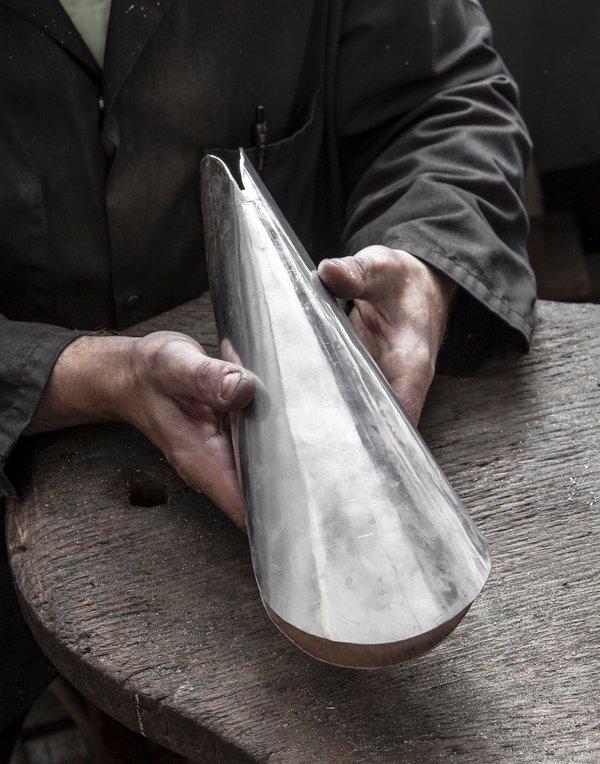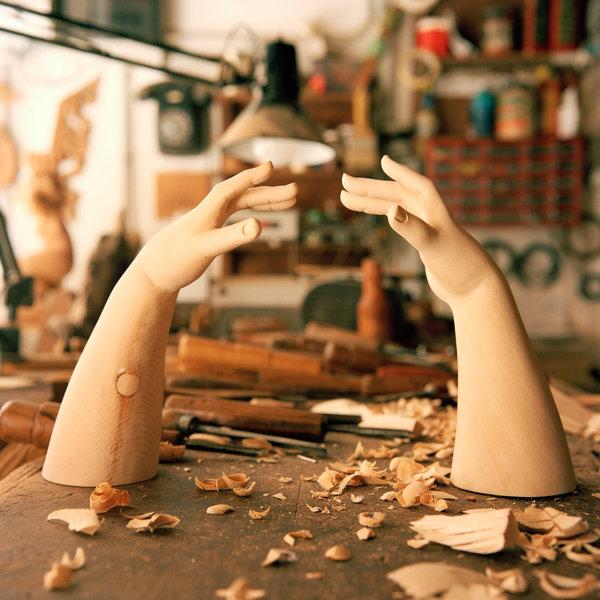
France’s Bettencourt-Schueller Foundation is featuring dozens of the artisans and designers it supports at Homo Faber. Here, the work of the goldsmith Nicolas Marischael and the designer Felipe Ribon.CreditCreditFelipe Ribon
By Tina Isaac-Goizé
The world may be tilting toward A.I., but the stuff of dreams remains deeply analog.
Such is the philosophy behind “Homo Faber: Crafting a More Human Future,” a monumental celebration of European craftsmanship that opens in Venice on Sept. 14.
The first edition of the event, planned for every two years, Homo Faber will be held in the Fondazione Giorgio Cini, which occupies the 16th-century San Giorgio monastery on San Giorgio Maggiore island. The event runs through Sept. 30; admission is free, as are vaporetto shuttles to and from St. Mark’s Square.
This exhibition is the brainchild of the Michelangelo Foundation for Creativity and Craftsmanship, a private nonprofit entity founded in Geneva in 2016 by Johann Rupert, chairman of the Swiss luxury group Richemont, and Franco Cologni, the former Cartier executive, entrepreneur, historian and author.
The Michelangelo Foundation’s raison d’être is to preserve fine craftsmanship, enhance visibility for creators by placing them on the global map and, crucially, attract a new generation of artisans.
To that end, the foundation has enlisted a little help from its neighbors for Homo Faber, which organizers have interpreted to mean “man is able to transform material, and hence craft his own destiny.” It is taking place under the patronage of the European Parliament.

The artistic richness of the Veneto region is highlighted in pieces like this wood sculpture, photographed by Susanna Pozzoli, who visited 21 regional workshops.CreditSusanna Pozzoli
Also, in a rare public display, France’s Bettencourt-Schueller Foundation will showcase dozens of the artisans and designers it supports at Homo Faber. Established by the late L’Oréal heiress and businesswoman Liliane Bettencourt, the foundation has been discreetly fostering master artisans in France for the past three decades. Other major event partners include Mr. Cologni’s namesake foundation for the artistic trades, the Triennale Design Museum in Milan and the Fondazione Giorgio Cini, where the event will be held.
Three years in the making, Homo Faber is billed as the biggest showcase of its kind — and the first cultural event to occupy all 43,000 square feet of the Cini Foundation’s available space. It counts 16 thematic pavilions overseen by 13 curators and a vast program encompassing art, photography, video, virtual reality, design, fashion, demonstrations, workshops, conferences and classical music concerts. The ambitious scope was a way of honoring Venice’s history as a hub of culture and trade.
Barely two weeks before the opening, Alberto Cavalli, an executive director of the Michelangelo Foundation and general curator of Homo Faber, conceded that he’d clocked some sleepless nights.
“Most people lay awake counting sheep. I’m counting artisans,” he joked.
Mr. Cavalli’s mind-boggling tally includes, thus far, 400 artisans and designers representing more than 300 métiers, and 900 unique pieces of art from 27 countries.
Included are historical figures such as the 17th-century Flemish master Anthony Van Dyck, whose “Ritratto di Marcello Durazzo” was recently restored by the Michelangelo Foundation for the city of Venice. As the headliner in the “Discovery and Rediscovery” exhibit, the painting, which dates to 1627, will be outfitted with a “smart” lighting system that lets visitors view it through a range of different lighting scenarios. Nine other works and expert restorers will be on hand to demonstrate their craft.
Along with historic masters like Van Dyck, many top contemporary names in fashion and luxury will be present at Homo Faber, including Alaïa, Chanel, Louis Vuitton and Van Cleef & Arpels.
Top designers are paired with master artisans in the Doppia Firma section of the show. The French designer Nathalie Dupasquier was matched with Emanuele Bevilacqua, a Venetian master brocade artisan.CreditLaila Pozzo
Some will host workshops in the Discovery pavilion to offer visitors a glimpse into the art of luxury craftsmanship.
Hermès, for example, will dispatch a master saddler, while artisans from Cartier will demonstrate the art of glyptic, or engraving on gems.
Lesage, the Chanel-owned embroiderer, will display archival samples of needlework and Luneville crochet and offer a collaborative workshop. Every day for two weeks, visitors will be able to work alongside two Lesage embroiderers to embellish a more than six-foot-long bird’s-eye view of Venice on toile fabric, adding blue-gray needlework to a canal, ocher to a palazzo, or cypress green to a garden.
Like everything else on display at Homo Faber, the Venice fabric map will not be sold. However, the online retailer YOOX, a sponsor and Richemont-owned company, will be selling objects by Homo Faber artisans on its platform starting on Sept. 14.
Elsewhere, the exhibitor list offers up some surprises. For the fashion section, which is presented in a mosaic-tiled former public swimming pool, the curator, Judith Clark, included younger, cutting-edge fashion houses like Hussein Chalayan, Phoebe English, Jacquemus and Off-White.
Yet for all their glamour and firepower, fashion and wearable luxury are arguably not Homo Faber’s biggest surprise. Its overriding purpose is to bring otherwise obscure talents to the attention of interior designers, gallerists, art lovers and well-heeled clients.
Rope-making is among the many crafts to be explored.
CreditHardanger Fartoyvernsenter
“Often, master craftsmen toil tucked away in their territories,” Mr. Cavalli said. “There’s this quaint stigmatism of, ‘oh you’re a shoemaker, how interesting (not).’ But artisans perfectly represent the uniquely human ability to craft something that stirs the heart.” Without a change in attitude, he noted, it will be difficult to inspire a new generation of master craftsmen.
In three years of scouting, Mr. Cavalli and his team — which includes a handpicked collection of curators, designers and architects — found a remarkable lineup of rare artists and objects.
Homo Faber’s wide range of disciplines, workshops and master artisans includes masters of gold leaf, enameling, feather-working and globe-making; designers of polypropylene sculptures or paper jellyfish; and makers of rope, wallpaper, home linens and even custom-made saddles for pack mules, found on a remote island in Greece.
Mr. Cavalli, 43, has spent two decades studying the ways of the luxury world. He credits his early experience working at fashion industry giants such as Dolce & Gabbana, Christian Lacroix and Thierry Mugler with introducing him to remarkable artisans (minimalism, he allows, is not his cup of tea).
Now a researcher, lecturer and author, Mr. Cavalli is intent on spearheading a cultural, and economic, renaissance for artisans.
“This is an economic initiative as much as a cultural one, because the truth is that honoring things with a soul is now more vital — and financially promising — than ever,” he said.
The two week-long event will offer an unusual opportunity to see the skills of an art restorer at close range.CreditAndrea Chiesi
The Michelangelo Foundation focuses primarily on unique collaborations, such as Doppia Firma, which invites renowned designers and artists like India Mahdavi, Nathalie du Pasquier and Giampiero Bodino to partner with highly specialized artisans from the Veneto region.
Framing Homo Faber as “an invitation to look and be inspired,” Mr. Cavalli said that he hoped visitors would come away with a renewed sense of wonder.
“It’s so difficult nowadays to inspire awe in people. Smartphones have spoiled us; you can travel anywhere through a screen, but nothing can shift your perspective like seeing the real thing,” he said.
Not that technology is the enemy, he added. In addition to its social media reach, Homo Faber is fully embracing technology. The “Singular Talents” section, for instance, presents artisans through 12 films, three of which have been turned into virtual reality experiences.
Mr. Cavalli, who also happens to serve as the general director of the Cologni Foundation, noted that this is how a cultural shift might really gain traction.
“For craftsmen, the real enemy is homogenization,” he said. “When everything is like everything else there’s no space for difference, no space for beauty.”
Advertisement







